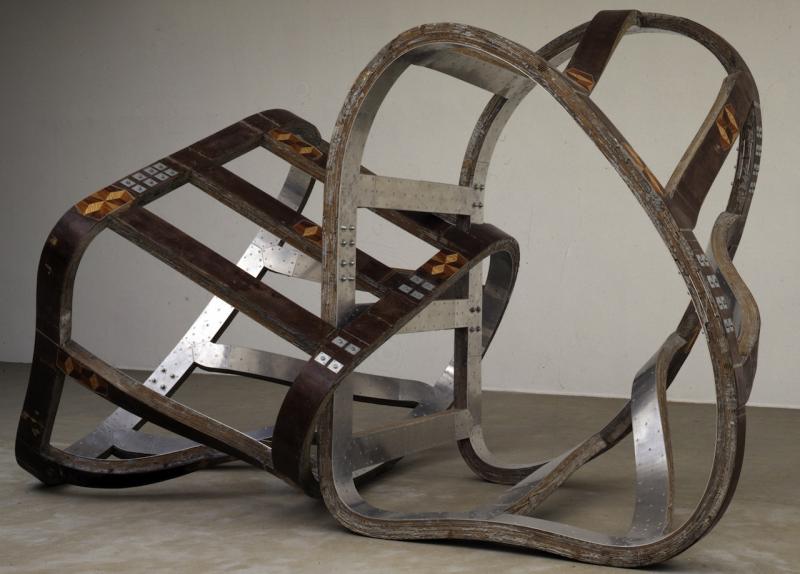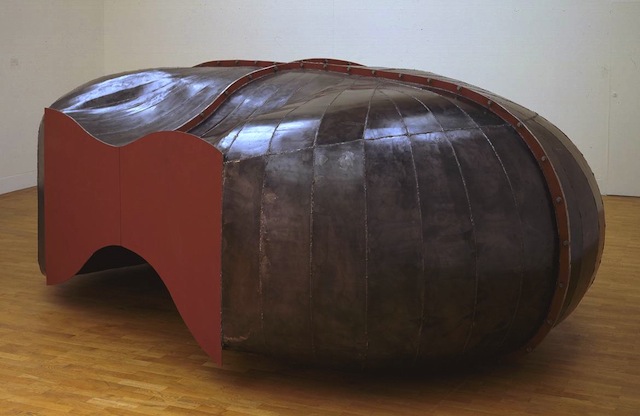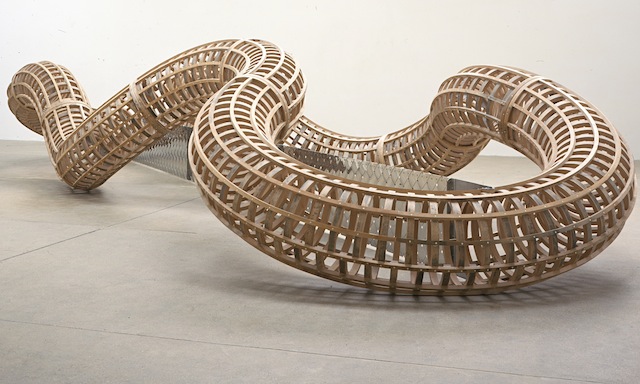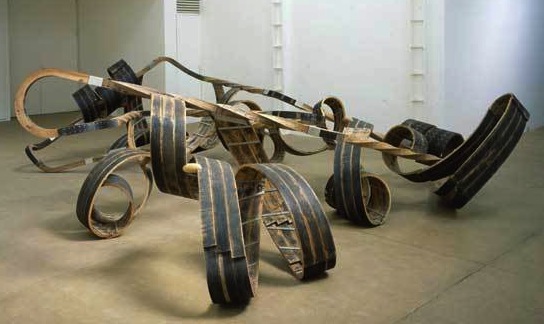Richard Deacon, Tate Britain | reviews, news & interviews
Richard Deacon, Tate Britain
Richard Deacon, Tate Britain
Extravagant forms and tensile structures in a powerful survey of the British sculptor

A retrospective is often a daunting prospect for all concerned, not least the poor visitor who must prepare for a gruelling marathon, visiting every forgotten cul-de-sac of an artist’s career.
With just 30 objects on display, it is certainly tempting to infer a brave curatorial strategy, emboldened by the reassuring presence of Deacon himself, who has been closely involved in the exhibition throughout. In reality, however, the show’s stripped back style must have been borne primarily out of necessity: Deacon’s sculptures are characterised by their grand scale and rambling, extravagant forms, which not only take up considerable floor space but demand a display area free from distractions. The curators have, nevertheless, been wise enough to make a virtue of this, adopting a pared back approach across the board, with the galleries kept as empty as possible, free from the usual clutter of barriers, labels and explanatory texts, allowing us to look at Deacon’s work unencumbered, with only the discreetly placed title of each work to inform our viewing.
The relationship between language and form has always been a preoccupation for Deacon
It is in these small but significant details that Deacon’s curatorial influence can surely be discerned; for him, the title is an essential part of the sculpture, setting up resonances and associations that merge and entwine with the object itself to inform and shape our understanding of it. The relationship between language and form has always been a preoccupation for Deacon, and beginning the exhibition with five drawings from the series It’s Orpheus When There’s Singing, 1978-9, provides a far better explanation of what follows than any text could possibly offer. Made using a pencil, a pin and a piece of string to draw arcs and circles from which a final form emerges, these drawings have a distinctly sculptural nature, Deacon describing the series as, “a process of trying to excavate a form from a developing set of lines”. The forms that emerge are often shell-like vessels, resembling ears, mouths and eyes, those body parts vital to generating meaning through language and experience, and which recur as motifs throughout Deacon’s career.
 The idea of an ear-like vessel occurs again in Struck Dumb, 1988 (pictured above), a mighty steel construction built at the Govan shipyards, its strange dark surface like a great industrial carapace, the red, wound-like panel on one side reinforcing the idea of a severed ear, or perhaps a mouth. Struck Dumb is an example of Deacon’s use of a title to great effect, the words nudging us towards a particular train of thought, and in this case setting up an almost overwhelming compulsion to discover what sort of noise this thing would make were we to strike it. But of course, no one is brave enough to find out, so we will never know: it is struck dumb. And there is another, more melancholy resonance here: this object has been made by an industry in terminal decline so that Deacon’s sculpture almost serves as a memorial to British shipbuilding, struck dumb.
The idea of an ear-like vessel occurs again in Struck Dumb, 1988 (pictured above), a mighty steel construction built at the Govan shipyards, its strange dark surface like a great industrial carapace, the red, wound-like panel on one side reinforcing the idea of a severed ear, or perhaps a mouth. Struck Dumb is an example of Deacon’s use of a title to great effect, the words nudging us towards a particular train of thought, and in this case setting up an almost overwhelming compulsion to discover what sort of noise this thing would make were we to strike it. But of course, no one is brave enough to find out, so we will never know: it is struck dumb. And there is another, more melancholy resonance here: this object has been made by an industry in terminal decline so that Deacon’s sculpture almost serves as a memorial to British shipbuilding, struck dumb.
 Setting up tension between object and viewer is something Deacon does brilliantly, nowhere more so than in the final rooms of this exhibition which contain two of his most stunning pieces of work, After, 1998 (pictured above) and Out of Order, 2003 (pictured below). Deacon has generally tended to emphasise the constructed nature of his sculptures, with lots of very obvious joins, rivets and screws flatly contradicting the sense of unity and completeness that often characterises his work. The vast structure of After uses the evidence of its construction to great effect; its flailing serpentine form is barely contained by a woven metal brace which restrains it with enormous bolts. The sculpture seems at breaking point, as if the bolts might suddenly fail, releasing this great monster of pent up energy writhing about the room.
Setting up tension between object and viewer is something Deacon does brilliantly, nowhere more so than in the final rooms of this exhibition which contain two of his most stunning pieces of work, After, 1998 (pictured above) and Out of Order, 2003 (pictured below). Deacon has generally tended to emphasise the constructed nature of his sculptures, with lots of very obvious joins, rivets and screws flatly contradicting the sense of unity and completeness that often characterises his work. The vast structure of After uses the evidence of its construction to great effect; its flailing serpentine form is barely contained by a woven metal brace which restrains it with enormous bolts. The sculpture seems at breaking point, as if the bolts might suddenly fail, releasing this great monster of pent up energy writhing about the room.
 A similar effect is achieved with Out of Order, its title suggesting the unnatural contortions the wooden components have been forced into, and filling us with a perverse anticipation of the sudden failure of a bolt or fastening, causing the whole thing to explode violently into life. Blackened in places by the steaming process used to shape pieces of oak into barley sugar twists and delicate curls reminiscent of wood shavings, the sculpture has the hulking, industrial feel of some of Deacon’s earlier work, and could almost be a piece of strange, complex machinery that has fallen into disrepair. Out of Order is capable of holding its viewers' attention indefinitely and for that extraordinary achievement must be worth the price of entrance alone.
A similar effect is achieved with Out of Order, its title suggesting the unnatural contortions the wooden components have been forced into, and filling us with a perverse anticipation of the sudden failure of a bolt or fastening, causing the whole thing to explode violently into life. Blackened in places by the steaming process used to shape pieces of oak into barley sugar twists and delicate curls reminiscent of wood shavings, the sculpture has the hulking, industrial feel of some of Deacon’s earlier work, and could almost be a piece of strange, complex machinery that has fallen into disrepair. Out of Order is capable of holding its viewers' attention indefinitely and for that extraordinary achievement must be worth the price of entrance alone.
Explore topics
Share this article
The future of Arts Journalism
You can stop theartsdesk.com closing!
We urgently need financing to survive. Our fundraising drive has thus far raised £49,000 but we need to reach £100,000 or we will be forced to close. Please contribute here: https://gofund.me/c3f6033d
And if you can forward this information to anyone who might assist, we’d be grateful.

Subscribe to theartsdesk.com
Thank you for continuing to read our work on theartsdesk.com. For unlimited access to every article in its entirety, including our archive of more than 15,000 pieces, we're asking for £5 per month or £40 per year. We feel it's a very good deal, and hope you do too.
To take a subscription now simply click here.
And if you're looking for that extra gift for a friend or family member, why not treat them to a theartsdesk.com gift subscription?
more Visual arts
 'We are bowled over!' Thank you for your messages of love and support
Much-appreciated words of commendation from readers and the cultural community
'We are bowled over!' Thank you for your messages of love and support
Much-appreciated words of commendation from readers and the cultural community
 Folkestone Triennial 2025 - landscape, seascape, art lovers' escape
Locally rooted festival brings home many but not all global concerns
Folkestone Triennial 2025 - landscape, seascape, art lovers' escape
Locally rooted festival brings home many but not all global concerns
 Sir Brian Clarke (1953-2025) - a personal tribute
Remembering an artist with a gift for the transcendent
Sir Brian Clarke (1953-2025) - a personal tribute
Remembering an artist with a gift for the transcendent
 Emily Kam Kngwarray, Tate Modern review - glimpses of another world
Pictures that are an affirmation of belonging
Emily Kam Kngwarray, Tate Modern review - glimpses of another world
Pictures that are an affirmation of belonging
 Kiefer / Van Gogh, Royal Academy review - a pairing of opposites
Small scale intensity meets large scale melodrama
Kiefer / Van Gogh, Royal Academy review - a pairing of opposites
Small scale intensity meets large scale melodrama
 Jenny Saville: The Anatomy of Painting, National Portrait Gallery review - a protégé losing her way
A brilliant painter in search of a worthwhile subject
Jenny Saville: The Anatomy of Painting, National Portrait Gallery review - a protégé losing her way
A brilliant painter in search of a worthwhile subject
 Abstract Erotic, Courtauld Gallery review - sculpture that is sensuous, funny and subversive
Testing the boundaries of good taste, and winning
Abstract Erotic, Courtauld Gallery review - sculpture that is sensuous, funny and subversive
Testing the boundaries of good taste, and winning
 Edward Burra, Tate Britain review - watercolour made mainstream
Social satire with a nasty bite
Edward Burra, Tate Britain review - watercolour made mainstream
Social satire with a nasty bite
 Ithell Colquhoun, Tate Britain review - revelations of a weird and wonderful world
Emanations from the unconscious
Ithell Colquhoun, Tate Britain review - revelations of a weird and wonderful world
Emanations from the unconscious
 Rachel Jones: Gated Canyons, Dulwich Picture Gallery review - teeth with a real bite
Mouths have never looked so good
Rachel Jones: Gated Canyons, Dulwich Picture Gallery review - teeth with a real bite
Mouths have never looked so good
 Yoshitomo Nara, Hayward Gallery review - sickeningly cute kids
How to make millions out of kitsch
Yoshitomo Nara, Hayward Gallery review - sickeningly cute kids
How to make millions out of kitsch
 Hamad Butt: Apprehensions, Whitechapel Gallery review - cool, calm and potentially lethal
The YBA who didn’t have time to become a household name
Hamad Butt: Apprehensions, Whitechapel Gallery review - cool, calm and potentially lethal
The YBA who didn’t have time to become a household name

Add comment